For such a momentous occasion as the birth of the baby-god Jesus, one might think that the first Christians would be quick to celebrate the event. Christmas is the second-highest festival on the Christian calendar and the most widely-celebrated holy day in history, but the fact is that it was an after-thought to the early church. The first generations of believers concentrated on the death and resurrection of Jesus and lived in profound expectation of his imminent return. What need was there to make a fuss over his humble origins when he would soon return again in glory to judge the living and the dead and to usher in a new heaven and a new earth?
As the years went by, and Christ seemed to be tarrying, the circumstances of his birth attracted more interest. Pagan critics of the new religion, such as Celsus, made mock of the claims of a virgin birth and asserted that Jesus was the illegitimate product of an adulterous union. Certain 2nd-century Christians, influenced by Greek Gnosticism, were skeptical of the idea of a god dwelling in human flesh – this was a repellent notion to the philosophers; the very purpose of the soul was not to become trapped in a body but to escape its earthly prison of meat and bone. These criticisms prompted the second-century Church to emphasize the truth of the nativity stories told in the gospels of Matthew and Luke and even to add to them in pious fictions such as The Protoevangelium of James which invented details about the youth of Mary and introduced the character of Salome, a midwife, to the events in Bethlehem.

By the year 200 Christian writers had begun to speculate about when the birth of Jesus had taken place and numerous dates were bandied about. This does not mean that Christians were seeking to know the date of the birth of Jesus in order to celebrate it. The theologian Origen declared that only pagan rulers had their birthdays trumpeted and, indeed, King Herod Antipas had given birthdays a bad name in the Christian community when he had used the occasion of his to order the execution of John the Baptist. Despite such a view, believers were growing fonder of recounting the story of the birth of Jesus. In Rome, where Christians gathered to worship in the funeral caves outside the city, they decorated a wall with a picture of the Nativity scene. The catacomb of St Priscilla bears an image of three Magi advancing toward the seated Virgin and child while a man standing beside her (probably meant to represent an Old Testament prophet) points to the guiding star in the heavens. Second and third-century pseudo-gospels such as The Revelation of the Magi were particularly interested in the appearance of the wise men who, guided by this miraculous star, became the first Gentiles to worship the Christ Child.
With the accession of the emperor Constantine in 312, Christianity became a legal religion, free to marks its holy days publicly, and the celebration of the Nativity soon was celebrated joyfully. During the 300s and 400s Christmas grew in importance on the church calendar as music, drama and liturgy were added in spectacular fashion. And then it occurred to someone – we know not who or where – that Christmas deserved a period of preparation such as Easter had with Lent. By the 500s there seems to have been a formally recognized fast beginning in mid-November on St Martin’s Day, a custom starting first in the Frankish church and then spreading in the West; other restrictions include a ban on matrimony, feasting and games. In Rome itself the Advent period, as it was now known, named for the Latin “coming”, was shorter, less penitential and more joyful and by the high Middle Ages the contrary tendencies had merged – the season had become shortened to a four-week fast with Lenten-type behaviour required. These restrictions, however, were abolished in the twentieth century and the season is now one of reflection and spiritual preparation.
For liturgical churches of the West it marks the beginning of the Christian year. It is reckoned as a period of four Sundays beginning with the one closest to St Andrew’s Day on November 30. The faithful are to use this time to prepare themselves worthily to celebrate the anniversary of the Lord’s coming into the world as the incarnate God of love and also to make themselves ready for His final coming as judge, at death and at the end of the world. In church services, there are glorious hymns and lessons that point us to the prophecies and promises of coming redemption and the importance of heeding the injunction “prepare ye the way of the Lord.”